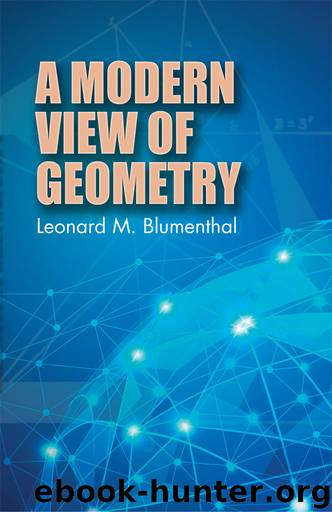A Modern View of Geometry by Leonard M. Blumenthal

Author:Leonard M. Blumenthal
Language: eng
Format: epub
Publisher: INscribe Digital
Published: 2017-09-01T04:00:00+00:00
Figure 18
Since x · y = T(x, y, 0), t + z = T(t, 1, z) (x, y, z, t ∈ Γ), it follows that T(x, y, z)=xy + z= T(xy, 1, z) = T[T(x, y, 0), 1, z].
We recall that a coordinate system was established in the affine plane Π by selecting an arbitrary point O of Π for the origin and by choosing three pairwise distinct lines on O and designating them the x-line, the y-line, and the unit line. On the unit line any point distinct from O was chosen and labeled I, and an arbitrary abstract set Γ was selected (subject to the sole requirement that there is a one-to-one correspondence γ between the points of the line OI and the elements of Γ), and γ(O), γ(I) were labeled 0, 1, respectively. Then a procedure was defined that established a one-to-one correspondence between the points of Π and the elements of the set of all ordered pairs of elements of Γ. The ordered pair of elements of Γ corresponding to a point P of Π are the coordinates of P. A ternary operation T(a, m, b) was defined in Γ, and the system [Γ, T] was called a planar ternary ring.
Now if a different point O′ of Π were chosen for the origin, and three lines on O′ selected as the x′-line, y′-line, and unit line (with point I′ selected on it), the same set Γ could serve as the coordinate set, since there exists a one-to-one correspondence between the elements of Γ and the points of the new unit line [each line of Π contains the same number (finite or transfinite) of points]. But the ternary operation T′, defined by the new lines and new origin, would, in general, be quite different from the ternary operation T defined by the original coordinate system (though the domain of the two operators is the same set Γ), so a different planar ternary ring [Γ, T′] would result. If the first Desargues property is assumed for Π, both operators T, T′ are linear; that is T(x, y, z) = xy + z, T′(x, y, z) = [x y] ⊕ z, where the addition ⊕ and the multiplication are, in general, different from the addition + and multiplication · defined by using the original coordinate system. We have established the following result.
THEOREM V.3.1. If the first Desargues property is valid in the affine plane Π, every (planar) ternary ring defined in Π is linear.
Is the converse of this theorem valid; that is, if every (planar) ternary ring defined in the affine plane Π is linear, does it follow that the first Desargues property is valid in Π? The answer is affirmative, as we shall now show.
THEOREM V.3.2. If every (planar) ternary ring defined in an affine plane Π is linear, Π has the first Desargues property.
Proof. Let A*, A′, A″ and B* B′, B″ be any two triples of points of Π (each two points distinct) such that lines
Download
This site does not store any files on its server. We only index and link to content provided by other sites. Please contact the content providers to delete copyright contents if any and email us, we'll remove relevant links or contents immediately.
Modelling of Convective Heat and Mass Transfer in Rotating Flows by Igor V. Shevchuk(6225)
Weapons of Math Destruction by Cathy O'Neil(5832)
Factfulness: Ten Reasons We're Wrong About the World – and Why Things Are Better Than You Think by Hans Rosling(4487)
Descartes' Error by Antonio Damasio(3166)
A Mind For Numbers: How to Excel at Math and Science (Even If You Flunked Algebra) by Barbara Oakley(3103)
Factfulness_Ten Reasons We're Wrong About the World_and Why Things Are Better Than You Think by Hans Rosling(3046)
TCP IP by Todd Lammle(3013)
Applied Predictive Modeling by Max Kuhn & Kjell Johnson(2907)
Fooled by Randomness: The Hidden Role of Chance in Life and in the Markets by Nassim Nicholas Taleb(2861)
The Tyranny of Metrics by Jerry Z. Muller(2849)
The Book of Numbers by Peter Bentley(2779)
The Great Unknown by Marcus du Sautoy(2538)
Once Upon an Algorithm by Martin Erwig(2473)
Easy Algebra Step-by-Step by Sandra Luna McCune(2469)
Lady Luck by Kristen Ashley(2416)
Practical Guide To Principal Component Methods in R (Multivariate Analysis Book 2) by Alboukadel Kassambara(2380)
Police Exams Prep 2018-2019 by Kaplan Test Prep(2358)
All Things Reconsidered by Bill Thompson III(2261)
Linear Time-Invariant Systems, Behaviors and Modules by Ulrich Oberst & Martin Scheicher & Ingrid Scheicher(2233)
